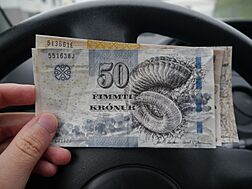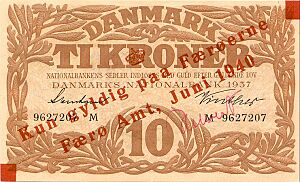Faroese króna facts for kids
Quick facts for kids Faroese króna |
|||
|---|---|---|---|
|
|||
| ISO 4217 Code | None | ||
| User(s) | |||
| Inflation | -1.1% | ||
| Source | The World Factbook, 2009 | ||
| Pegged with | Danish krone at par | ||
| Subunit | |||
| 1⁄100 | oyra | ||
| Symbol | kr | ||
| Plural | krónur | ||
| oyra | oyru(r) | ||
| Coins | Danish coins circulate: 50 oyru(r), 1, 2, 5, 10, 20 krónur | ||
| Banknotes | |||
| Freq. used | 50, 100, 200, 500 kroner | ||
| Rarely used | 1000 krone | ||
The króna (plural: krónur) is the money used in the Faroe Islands. It is issued by Danmarks Nationalbank, which is the central bank of Denmark. Even though it has its own name, the króna is not a separate currency.
Instead, it's a special version of the Danish krone used only in the Faroe Islands. This means that Danish coins are used there. Because it's not a separate currency, the króna doesn't have its own official code like USD for US dollars. It uses the same code as the Danish krone, which is DKK.
When you use a credit card in the Faroe Islands, you'll see the charges in Danish kroner. One króna is divided into 100 oyru(r).
Contents
How the Faroese Króna Began
Money During World War II
When German forces took over Denmark on April 9, 1940, the Faroe Islands were also using the Danish krone. But because of the war, the Faroe Islands and Denmark couldn't easily exchange money anymore. This meant their money systems started to develop separately.
On May 31, 1940, special Faroese banknotes were created. These were Danish notes that had a unique stamp on them. They replaced the regular Danish notes.
Later, on October 14, 1940, new banknotes were printed. These notes said they were "on behalf of the National Bank of Denmark." They had the same value as the notes already in use.
Controlling the Money Supply
To manage foreign trade and make sure the Faroe Islands had enough money, a "Currency Central" was set up on December 18, 1940. A group of nine people led this central office. They included a judge, people from fishing and merchant groups, and representatives from local banks and the Løgting (the Faroese parliament).
Linking to the British Pound
On December 18, 1940, the Faroese króna was officially linked, or "pegged," to the British pound. This meant that 22.4 krónur were equal to 1 British pound. The British government agreed to this in a special treaty on March 27, 1941.
At the same time, the Currency Central group became smaller, with only three members. These included a representative from the British Government, one from the Danish State (for the Faroe Islands), and one from the Løgting. In 1941, special coins were even made in London for use in the Faroe Islands.
Linking Back to the Danish Krone
On April 12, 1949, the Faroese króna was no longer linked to the British pound. Instead, it was fixed to the Danish krone at the same value. This arrangement is still in place today. Even though Faroese banknotes were issued "on behalf of the National Bank of Denmark," the Danish National Bank doesn't claim ownership of Faroese banknotes made before 1951.
Exchanging Faroese and Danish Krónur
The National Bank of Denmark exchanges Faroese krónur for Danish krónur (and vice versa) for free. Even though regular Danish banknotes are not officially the main money in the Faroes, people there accept them everywhere.
In Denmark, many people don't know much about the Faroese króna. They might not realize it's officially the same currency as the Danish krone. Also, they might not know that Danish banks can exchange the notes for free. Because of this, very few stores in Denmark will accept Faroese notes. Money exchange places in other countries also often have trouble with them. So, people traveling from the Faroe Islands are often told to exchange their cash before they leave to avoid problems.
Coins Used in the Faroe Islands
The Faroe Islands use the same coins as Denmark. However, there have been times when there weren't enough small coins. This led to some special coins being made.
Early Special Coins
In the late 1800s, a German merchant named C.F. Siemsen, who did business in both the Faroe Islands and Iceland, made his own private coins. These coins were made of brass. One side had "CFS" and the other side showed the value, like "4" or "16 skilling in goods."
Later, from 1929 to 1933, two other merchants also made their own coins because of a coin shortage. J.F. Kjølbro in Klaksvík made aluminum coins in values like 10, 25, and 50 øre, and 1, 2, 5, and 10 kroner. S.P. Petersens Eftf in Fuglafjørður made brass coins in values like 5, 10, and 25 øre, and 1, 2, and 5 kroner.
World War II Coins
During World War II, the Faroe Islands were separated from Denmark. To help with a shortage of small change, a set of coins (1, 2, 5, 10, and 25 øre) was made in London in 1941. These coins looked like the Danish coins used before the war.
You can tell them apart because the London-made coins were bronze and copper-nickel. The Danish coins made in 1941 were mostly aluminum and zinc. Also, the British-made coins don't have the small heart mark of the Royal Danish Mint or the initials of the engraver from Copenhagen.
Faroese Banknotes
In 1940, Danish banknotes (5, 20, 50, 100, and 500 kroner) were stamped with a message. It said "Only valid on the Faroe Islands, Faroe County, June 1940." This made them special for use there. Later that year, the Faroe County issued its own distinct notes for 1, 5, 10, and 100 kroner.
From 1951, the notes started to have text in the Faroese language. The 1 króna note was stopped. New notes were introduced over the years: 50 krónur in 1967, 500 and 1000 krónur in 1978, 20 krónur in 1986, and 200 krónur in 2003.
Modern Banknotes and Security Features
Between 2001 and 2005, a new series of banknotes was released. These notes had new security features to make them harder to copy. The values are 50, 100, 200, 500, and 1000 krónur.
On March 19, 2012, an updated version of these banknotes came out. They look the same as the earlier ones but have even better security features. For example, they now have "Motion" security threads that move when you tilt the note. They also have perfect registration devices and special colors that glow under UV light.
| Image | Value | Dimensions | Main colour | Description | Date of issue | |
|---|---|---|---|---|---|---|
| Front | Back | |||||
| 50 kroner | 125 × 72 mm | Blue | Ram's horn | Cliff near Sumba | 3 July 2001 | |
| 100 kroner | 135 × 72 mm | Gold | Cod's tail | Klaksvík | 16 January 2003 | |
| 200 kroner | 145 × 72 mm | Purple | Ghost moth | Tindhólmur | 19 January 2004 | |
| 500 kroner | 155 × 72 mm | Green | Shore crab | Hvannasund | 30 November 2004 | |
| 1000 kroner | 165 × 72 mm | Red | Purple sandpiper | Sandoy | 15 September 2005 | |
Bank Transfers and Codes
When you send money internationally, banks use special codes. The Faroese króna doesn't have its own official ISO 4217 code. So, for credit card statements and international transfers, the code DKK (for Danish krone) is used.
However, transfers between Denmark and the Faroe Islands are still seen as international. This means they might have fees. The Faroe Islands also have their own IBAN (International Bank Account Number) and BIC (Bank Identifier Code) that start with FO.
Collecting Faroese Banknotes
If you're a collector of money, this is called Numismatics. Faroese banknotes are no longer sold to collectors by Danmarks Nationalbank. Their online shop closed at the end of 2023. Postverk Føroya, which is the Faroese postal service (now called 'Posta'), used to be the only place for collectors to buy Faroese banknotes. However, they don't sell banknotes anymore either.
See also
- Exchange rate regime
- British occupation of the Faroe Islands in World War II
- Economy of the Faroe Islands



